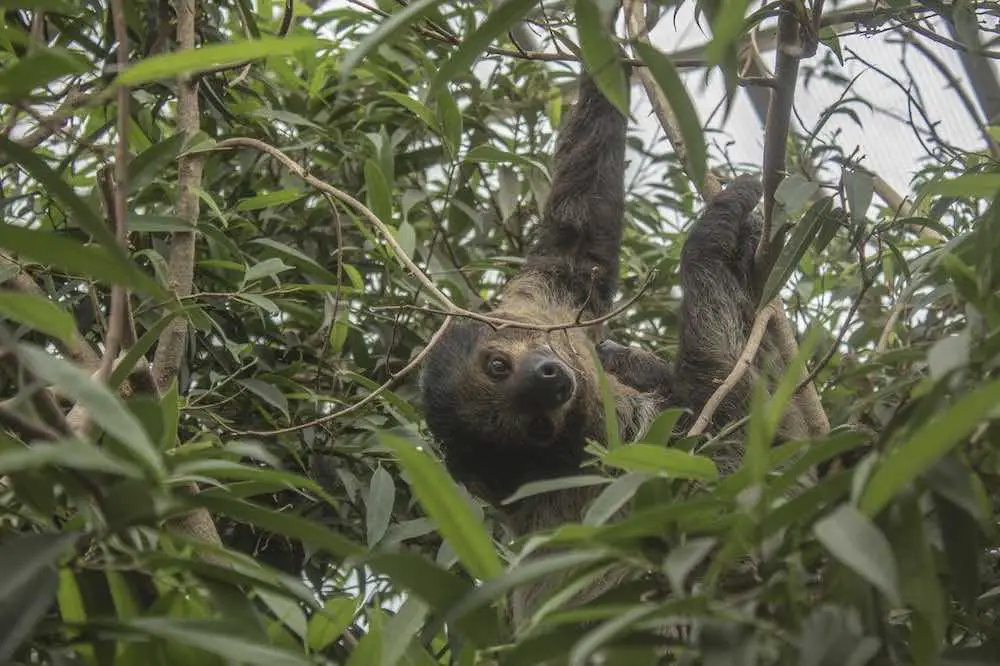
The poor old sloth really has quite a bad reputation for being slow and not really doing much. But is this the case? I wanted to look into this a bit further and wanted to know the answer to the question how do sloths help the environment?
So then how do sloths help the environment? Sloths help the environment by eating leaves from trees, allowing sunlight into the rainforest. They fertilise trees by defecating at the base. They have an ecosystem in their fur which allows creatures to grow, and could provide a cure to some diseases. They are food for predators such as jaguars.
The above answer really only scratches the surface of how exactly sloths are good for the environment in which they live.
I have gone into much more detail below about their relationship with trees and the creatures that live in their fur. You can also read a little more about how exactly this could be used to cure diseases. Keep reading to find out more.
Contents
How Do Sloths Help The Environment?
For the purposes of this post I am just really talking about sloths in general. There are actually 6 different types of sloths, split across two genera, the two-toed and the three-toed sloths. There are also 12 different subspecies. For more information about the different species of sloths you can read this post.
Generally speaking sloths live in forested areas, mostly the rainforests of South America, although across the species they do span a vast amount of countries.
You are not likely to ever come across a sloth in daily life really, and sloths are not particularly dangerous to humans. They are, however, extremely helpful to the environment.
Let’s take a look in some more detail at exactly how they help the environment in which they live.
Do Sloths Help The Environment By Eating Leaves?

It seems fairly obvious to say this, but trees play a huge part in the ecosystem of the rainforest. In fact they play a huge role in the ecosystem of the entire planet.
As we know, trees take carbon dioxide and turn this onto oxygen. Without this we all die right?
Now I could write a whole post just on the amount of oxygen rainforests such as the Amazon Rainforest produces. It has been a widely held ‘fact’ that the tress in the Amazon produce 20% of the Earths oxygen supply.
However, Factchecker.org and many other sources claim it is closer to between 6% and 9%.
All of the different types of sloths live in trees, both due to the fact that they can survive solely on the food provided here, and because sloths are fairly well protected up in the canopies. Although not entirely protected!
Due to the fact that it takes a sloth so long to digest food, they tend to go for the younger, softer leaves. Sloths will eat a lot of leaves from trees, and you could say that they work as gardeners, pruning the trees and stopping them from becoming too overgrown.
This allows for some sunlight to break through the trees into the rainforest below. It also allows for the trees to send its energy resources to the more fully developed leaves for producing oxygen.
So when we are thinking about how do sloths help the environment, their choice to stay in trees and eat their leaves actually pays off here.
How Does A Sloths Toilet Habit Help Trees?
Much has been written on the internet about the toilet habits of sloths. So much so that almost every post I come across talks about this. The danger of sloths going to the toilet. How they should fear for their lives etc.
Yes, I am aware that I am now doing the same thing by writing about this very topic.

But there is some truth in this. Sloths have an insanely slow metabolism. The leaves that they eat can take anywhere between 30 and 50 days to be digested. This is one of the reasons they tend to go for younger, softer leaves. They are simply easier to digest!
Due to this slow metabolism and the slow digestion of food, they don’t need to go to the toilet as often as we do. This is actually a useful adaptation that sloths make use of.
Also think about it! You are literally one of the worlds slowest creatures. It takes you forever to do anything. The climb down and then back up a tree takes forever.
When you get to the bottom you are in severe danger of being attacked and killed by predators on the ground. If this is you, and you don’t need to go, you won’t. Probably right until the last minute.
Again we knows sloths live alone, and so probably inhabit their own tree, or a large part of it.
When they climb down to go to the toilet, their body weight is roughly 30% waste that they will get rid of. This actually helps sloths to be good swimmers by making them buoyant.
Coming down from the tree to go to the toilet is a great way for the trees to receive fertiliser and nutrition.
When thinking about the question how do sloths help the environment, this is a definite plus point here. They eat the leaves from the trees, and then they go down and fertilise those very same tress, helping them in turn to grow. It’s a mini circle of life right there!
A Sloths Fur Has It’s Own Ecosystem Which Is Good For The Environment
As well as the toilet habits of the sloth, the other often written about aspect of our friend the sloth is the fact that it appears to have its own ecosystem right there in its fur.
As I mentioned above, there are 6 different types or species of sloths, with even more subspecies. They all have their own distinct color of fur, and look different in many ways.
But when you see pictures of the different types of these living in the wild, sloths can appear to have green fur. This comes from algae which forms and grows on a sloth.
This is in part due to the fact that they stay so still, and they live in an area that is usually both hot and humid.
Now for me the idea of having green algae growing on me repulses me. But not the humble sloth. Because what else is green? The trees that they live in right?
So being covered in green algae actually really helps a sloth to stay camouflaged, especially from those birds like harpy eagles that will swoop in to grab them and carry them away.
Now the next part helps us in our answering the question of how do sloths help the environment. The algae and dead cells within the fur of the sloth provide nutrients for a whole host of other creatures, such as beetles, moths and flies to name a few.
So then sloths end up having these creatures living in their fur. This provides them with a relatively safe place to live, and with enough food to survive on.
These creatures can in turn provide food for other small animals living in the rainforest. Who would have thought so much was going on with sloths right?
Some people even say that when leaves are scarce, sloths will eat some of these creatures as an extra food source, although he we don’t really know for sure if this is true.
When sloths go down to use the toilet, the waste or poop that they produce also provides an excellent place for the creatures living in their fur to lay eggs.
Can Sloths Help To Fight Diseases?
This really follows on from the point above about the ecosystem in the fur of sloths. I found many sources that talk about how sloths can aid in the curing of some diseases due to the growth in their fur. Who knew sloths were so smart?
Whilst I don’t believe any new medications have been created as a result of the findings in the sloths fur, they certainly are being studied right now.
Findings so far suggest that some fungal strains have been found that could protect against malaria causing parasites. There is also the possibility that chemicals found in the sloths fur could be used to fight against diseases such as breast cancer.
Providing Food For Other Animals Helps The Environment Too
It is sad to say in some ways for the poor sloth, but the circle of life is not just a song from the Lion King movie. It is a very real circle that sloths are a part of.
It is absolutely true to say that sloths play a very important part in maintaining and supporting the ecosystem of the places they inhabit, in particular the rainforests of South America.
We also know that for a number of reasons these areas are in decline. Due to deforestation for a number of reasons, and due to global warming, the areas a sloth inhabits are becoming smaller and smaller. They do play a vital role in helping to maintain this.
However, they also play another role in the circle of life, particularly in the rainforests. There are a number of sloth predators that will be only too happy to eat up the humble sloth.

Sloths can be hunted by a number of different animals in their natural environment. One of the biggest threats from the animal kingdom comes in the form of animals from the wild or big cat family.
Members of this family know for hunting sloths are jaguars, ocelots and margays. Whilst jaguars and ocelots are most likely to catch a sloth off guard when they come down for their toilet trek, margays are extremely capable climbers.
Whilst we know that sloths like to live high up in the canopies of rainforests, and camouflage themselves well, they are not safe completely from ground predators such as these.
From the skies sloths can be under attack from a number of winged predators. Eagles such as the harpy and crested eagles, and also the spectacled owl can swoop down and grab sloths from high up in the canopies of rainforests.
Unfortunately for sloths both of these eagles will make their homes in the very place that sloths go to for refuge.
It is also widely written that sloths can and do swim. So they’re safe here right? Not so much. Again jaguars are excellent swimmers, and it is well reported that they can hunt and kill prey in the water, and are strong enough to carry their prey while they swim.
The anaconda, a water dwelling constrictor snake also lives in these very same waters. Sloths will often swim between areas of rainforests via rivers as they can do this quicker than walking. Any sloth making this journey is easy prey for an anaconda if it wants to grab it and squeeze it to death.
In the circle of life, animals such as jaguars hunting sloths isn’t always such a bad thing. Jaguars are sometimes known as a keystone species, as they help to keep in check herbivorous and granivorous animals so that not too much of the rainforest is eaten by them.
Without human intervention on this planet, the animal kingdom has an amazing way of keeping things in balance.
Summing Up
So how do sloths help the environment? Well simply by being alive they are able to do this. They help both trees and the rainforest in general simply be eating their leaves.
They also help trees immensely by using the toilet at the foot of the trees. This provides trees with vital nutrients that seep into the soil.
Sloths have a whole ecosystem right in their own fur. Here they allow creatures to grow, which can either be eaten by sloths or by other animals in the rainforests.
This ecosystem in their fur is also creating quite a stir in the medical world, as many believe it will provide the cure to diseases such as cancer, and it can help to kill of malaria carrying parasites.
Lastly, and sadly for the sloths, they also play their part in the food chain, providing food for apex predators such as jaguars.
I hope you found the information in this post useful in answering the question of how do sloths help the environment.
if you have any questions or want to add anything to this post, then please leave a comment below.
